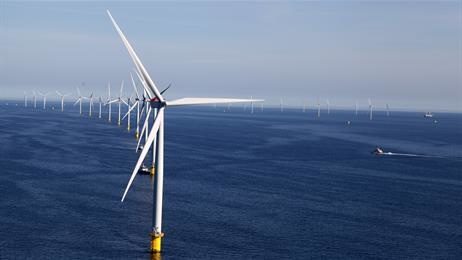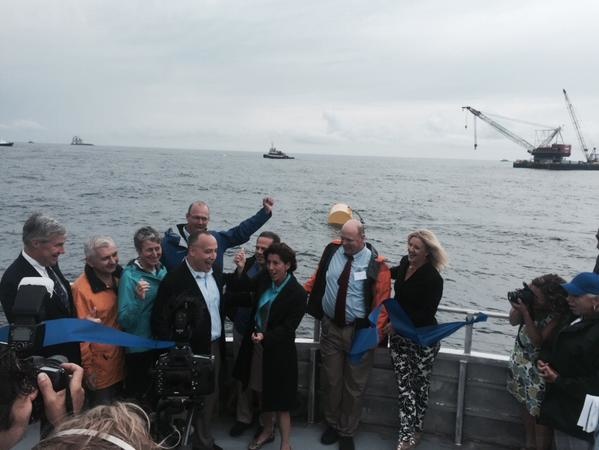News Release from windfair.net
Wind Industry Profile of
US: Europeans come to aid the US Offshore Wind Market
The American public has displayed a reserved relationship to offshore wind energy so far although the first project is finally constructed off the coast of Rhode Island, where currently the foundations of Block Island wind farm are getting installed. But other big projects like Cape Wind already failed. Now, however, the US finally seems to get into the offshore wind business – and just off the coast of Massachusetts where the Cape Wind farm should have been built years ago.
Who else is to blame than – no surprise here – the Europeans? European companies have long been eying the lucrative US market, especially since the US Department of Energy has recently released new figures on the potential of offshore wind in American waters. The number is as high as nearly 4,150 Gigawatts and offers apparently limitless expansion opportunities. Basic requirement: Being present from the very beginning.
So it's no wonder the worldwide leader in offshore wind project development DONG Energy pushes for the US market. The Danes have recently been awarded a contract in one of the American bidding rounds and have now announced first details of their plan to build an offshore wind farm. The proposed location is 25 kilometers south of the island of Martha's Vineyard where DONG wants to install 100 turbines.
Comparisons with the much smaller Cape Wind Project which failed i.a. because of the protest of inhabitants of the region are obvious. Quickly, DONG highlighted the differences: The company has great experience in the construction of offshore wind farms, as well as the turbines are to be installed much further out at sea. Even on a clear day they are barely visible from the coast. Thomas Brostrom, general manager of the North America division of DONG Energy, stressed in the Boston Globe: “We have the experience and we have expertise."
That even seems to convince the opponents of the Cape Wind project. The 'Alliance to Protect Nantucket Sound', so far most determined opponents of Cape Wind, is welcoming the plans by DONG Energy. Audra Parker, president of the Alliance, said: “We find these areas to be far more superior (than the Cape Wind area/ed. note)."

The Anholt Offshore Wind Farm was constructed by DONG Energy (Photo: DONG Energy)
Another advantage is the financing of the project: While Cape Wind got into trouble after two investors were bailing out, this is something that will not happen with DONG. The company expects to be able to bear the costs all by themselves. "It's not daunting to us. We know what we're doing", said Brostrom to the Globe. He also cited the comparability to projects in the North Sea. Wind and soil conditions are similar, even if more details must be confirmed in lengthy reports and tests in the coming years.
Declining costs in the offshore wind industry in general also contribute to the fact that it seems possible to convince the Americans now. Thus, the US Department of Interior recently hosted the fifth offshore auction where two areas with a potential of up to 3400 MW off the coast of New Jersey were sold. The tender was awarded to the companies RES America and US Wind. "We are pleased to see continued commercial interest in the offshore wind industry, as demonstrated by today's lease sale", said BOEM Director Abigail Ross Hopper in a statement.
Until there are actually turbines spinning off the coast of New Jersey, however, it may take a while, because both tender winners have now initially a year's time to submit their detailed plans. In turn, these plans need the approval of the authorities – both on national and regional level. As history shows, other projects have already failed or are struggling with these requirements as the project of Fishermen's Energy in Atlantic City shows.
Therefore, a different approach is currently tested on the American West Coast by Trident Winds. They are currently working on plans for a floating wind farm, because the seabed drops steeply shortly before the coastline making floating turbines the only way to reap the abundant blowing wind on the Pacific coast. Currently, Alla Weinstein, CEO of Trident Winds, is trying to gather support for the project in California. "It's not oil. It's not fossil fuel. It doesn't spill. It's energy from the jet stream, as pure as it comes", she says.
The company eyes an area in front of the small town of Morro Bay. According to the will of the company from Seattle, they will soon erect a floating wind farm with a capacity of 1000 MW there. Although California comes in second after Texas concerning onshore wind energy production, there haven't been any offshore activities so far. No wonder, residents and local fishermen, who fear for their fishing grounds are skeptical. “They want an area where a lot of guys fish", says Tom Hafer, president of the Morro Bay Commercial Fishermen's Organization to the San Jose Mercury News. "We are willing to work with her on it. (But) We're worried.”
Environmentalists don't really know what to make of offshore wind yet. Andrew Christie, director of the local Sierra Club's chapter (the largest environmentalist organization of the United States) has mixed feelings: "All we know right now is that it is very big and it is going to float. It won't be ramming concrete pylons into the ocean floor, which is good. We're concerned about migrating whales, night lighting and birds in general. Are the blades going to be slow enough to prevent them from becoming bird fricassee?"
His colleagues from the East Coast have now come to the realization that offshore wind could be the lesser evil in energy production, which is why Emily Norton from the Sierra Club Massachusetts recently participated at the inauguration ceremony for the Block Island wind farm. She wants to remember that day and tell her kids about it. "When we had a choice between bequeathing them a future powered by polluting fossil fuels that lead to extreme storms, heat waves and drought, we chose to power their future from the wind, and the sun, and smart technologies.”

Inauguration ceremony for the Block Island wind farm (Photo: Clint Plummer, vice president of Deepwater Wind, on Twitter)
- Author:
- Katrin Radtke
- Email:
- kr@windmesse.de
